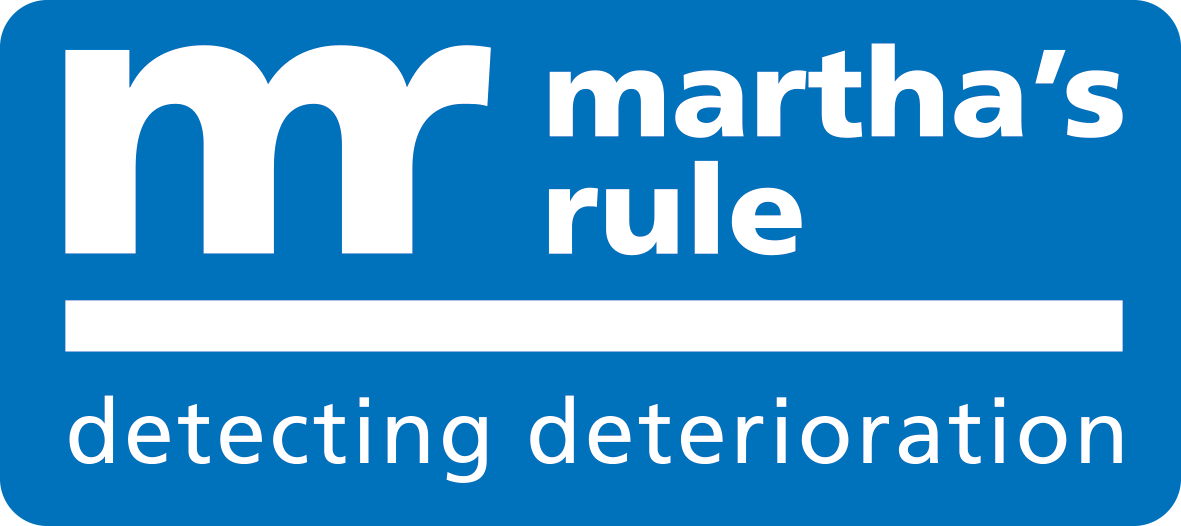You know yourself or your loved one better than anyone. If you’re worried about a health condition getting worse, talk to us.
What is Martha's Rule?
We have introduced Martha’s Rule to help spot any unexpected signs and give you the right to request a rapid review if you’re worried that your or your loved one’s condition is getting worse.
You may notice small changes before they show up in our routine tests. These changes could be early warning signs that someone’s condition is getting worse.
- Martha's Rule is also known as 'Call if concerned' in some of our hospitals. We're changing the name to Martha's Rule but the phone numbers remain the same.
How we monitor patients
We regularly check patients’ vital signs, such as heart rate, temperature, and blood pressure. The frequency of these checks will depend on the patient’s individual condition. Sometimes we need to wake patients to do these checks.
We will also ask patients at least one time every day if they are feeling better or worse. This is to help spot any unexpected changes in their condition.
What to do if you're worried
1. First, speak to the team that’s caring for you or your loved one.
2. If, after speaking to the care team, you are still worried and feel your concerns are not being addressed, call for a rapid review.
We check the answerphone often, so please call us and leave a message.
If you are concerned about a child’s condition:
- Call 020 7188 6404
- Children’s services at Royal Brompton and Harefield hospitals are provided by Evelina London Children’s Hospital. Find out about Martha’s Rule at Evelina London.
If you are concerned about a patient's condition, call:
- Harefield Hospital: 07855 986 074
- Royal Brompton Hospital: 07971 301 358
- Email for Royal Brompton Hospital only gstt.cic@nhs.net
You should include:
- the patient's name
- the name of the ward
- a brief description of your concern
- what has already been done
- your name, contact details, and relationship with the patient
What we’ll do
Your call will go to a different team in our hospital, who specialise in the care of critically-ill patients. When they get your message, they will:
- visit the patient to check on their condition
- talk to medical staff and other health professionals looking after the patient as needed
- agree actions with the staff looking after the patient
If the patient gives us permission, we'll call you back to let you know the actions we have taken, and tell you how they are.
This service is available 24 hours a day, 7 days a week.
If you have other concerns or questions, contact:
- your service at first, if it's about the patient's care, an appointment, scan, surgical date or any other outpatient visit
- the Patient Advice and Liaison Service (PALS) for questions, comments or concerns
Our commitment
We will regularly ask for your views and take your concerns seriously. We see you as a partner in the care we give, and want you to raise any worries you have.
Difference between Martha’s Rule and getting a second opinion
Martha’s Rule allows hospital inpatients and their families to get a rapid review if a patient’s condition is getting worse.
A second opinion is when you want to see a different consultant to discuss any diagnosis or treatment. This is not usually within an emergency setting or an intensive care unit.
Background of Martha’s Rule
Martha Mills died in 2021 after developing sepsis in hospital. She had been admitted with an injury to her pancreas after falling off her bike. The care team did not act on her family’s concerns about Martha’s condition getting worse.
In 2023 a coroner ruled that Martha, aged 13, would probably have survived if she had been moved to intensive care earlier.
Royal Brompton and Harefield hospitals used to call this ‘Call if concerned’, but it’s now called ‘Martha’s Rule’ and is active across every NHS site in England.

